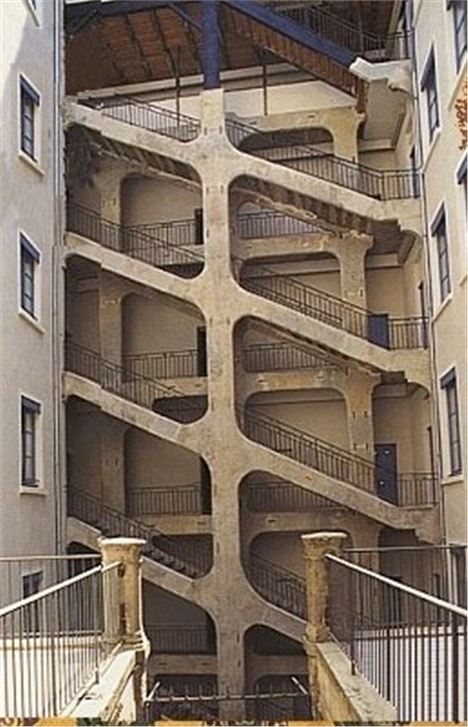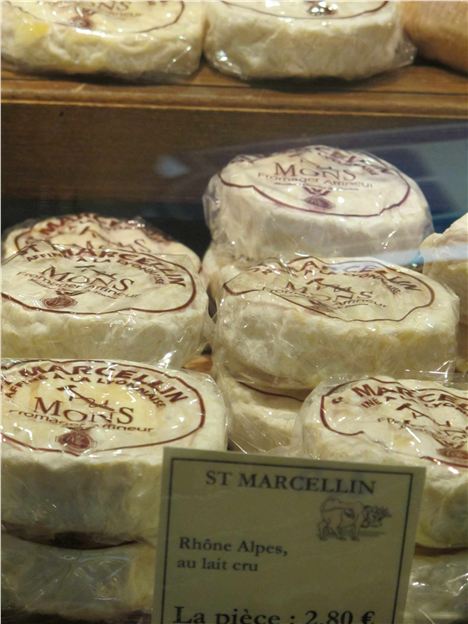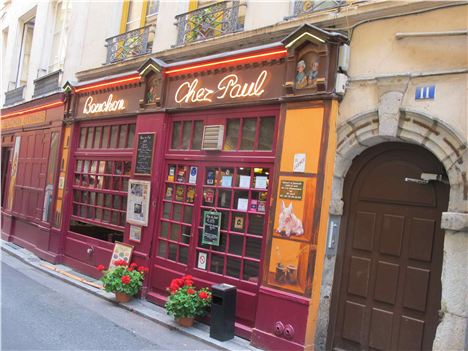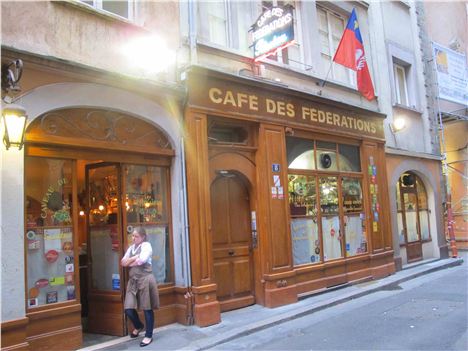MY dreams of Lyon are populated with the limp heads of pampered poultry and the wicked fixed grins of Guignol puppets. The stuff of nightmares, you say? No, of joy. La Joie de Vivre. Superficially stern, the city where two great rivers converge overflows with the pleasures of life.
 Maison De Guignol where the puppets take centre stage
Maison De Guignol where the puppets take centre stage
The pleasures of the true flesh, eating, are exemplified by the rows of Bresse chickens (and so much, much more) in the Halles de Lyon-Paul Bocuse market and the restaurant culture that ranges from Bocuse’s Michelin three-star temple down to the earthy gourmandise of the backstreet “bouchon” bistros.
 The Rhone – one of the two major rivers which flow through the city
The Rhone – one of the two major rivers which flow through the city
Guignol is a more anarchic treat. Let’s start with him on our whirlwind visit to France’s second city. Our invaluable Lyon City Card (see Factfile) gave us access to many attractions. Particularly in Vieux Lyon (the Old Town, on the west bank of the Saone river) there seemed a preponderance of puppetry going on. What did it all mean? It was hard-going to find out at first. We were in town on a Monday and Tuesday when the fabled Gadagne International Puppet Museum was shut, while there were no current performances at the quarter’s two puppet theatres.
 Guignol's bizarre worldStill there was the more modest Small Museum of Guignol’s Fantasy World on the Old Town main drag, the Rue St Jean. The shop part is fun, but just the start. Descend to the basement and you enter a puppet parallel universe with various tableaux, some automated, many featuring Guignol, who is a kind of impish tutelary spirit of the city.
Guignol's bizarre worldStill there was the more modest Small Museum of Guignol’s Fantasy World on the Old Town main drag, the Rue St Jean. The shop part is fun, but just the start. Descend to the basement and you enter a puppet parallel universe with various tableaux, some automated, many featuring Guignol, who is a kind of impish tutelary spirit of the city.
The character was invented at the end of the 19th century by a silk weaver called Laurent Mourguet. Lyon’s traditional silk trade was going through a bad patch, so Mourguet became an itinerant salesman then a puppeteer with a mobile theatre and a Mr Punch. He created Guignol, as a likeable rebel championing the underdog. He’s immensely popular to this day.
 Maks in the Model And Cinema Decor Museum
Maks in the Model And Cinema Decor Museum
 Model and Cinema Decor Museum - life masks of the stars
Model and Cinema Decor Museum - life masks of the stars
Close by is an equally playful museum but with lots more to see. Long before Hollywood, Lyon was the birthplace of cinema (a specialist museum, the Lumiere Institute traces those pioneering days, www.institut-lumiere.org); the Miniature and Cinema Decor Museum brings the story up to date in its rooms explaining how those astonishing special special effects work. Lots of Hollywood here – the Jack Nicholson and Angelina Jolie plaster life masks live on with me.
The rest of the exhibition space is devoted to the work of miniaturists from across the globe. Their patient attention to detail is equally astonishing. Check out Dan Ohlmann’s “Reals”, faithful reproductions of classic Lyon places, such as the early 19th century Brasserie Georges in the main rail station, Perrach. The Museum’s own setting is rather wonderful – the galleried 16th century Maison des Avocats.
 Looking up at Notre Dame de Fourviere from the Cathedral Square
Looking up at Notre Dame de Fourviere from the Cathedral Square
 Astronomical clock But then this UNESCO World Heritage Site boasts the largest collection of Renaissance buildings outside Venice. An essential walk, to get the classic Lyon view is up Fourviere Hill. The large white wedding cake of a church on top, the Notre Dame de Fourviere dominates the cityscape but, up close, is as lumpen as its Paris cousin, Sacre Coeur. Both were built to trumpet the enduring triumph of the Catholic Church after the turmoil of the Communes. In contrast, the Cathedrale St-Jean immediately below on the banks of the Saone, is a medieval gem with a beautiful 14th century astronomical clock.
Astronomical clock But then this UNESCO World Heritage Site boasts the largest collection of Renaissance buildings outside Venice. An essential walk, to get the classic Lyon view is up Fourviere Hill. The large white wedding cake of a church on top, the Notre Dame de Fourviere dominates the cityscape but, up close, is as lumpen as its Paris cousin, Sacre Coeur. Both were built to trumpet the enduring triumph of the Catholic Church after the turmoil of the Communes. In contrast, the Cathedrale St-Jean immediately below on the banks of the Saone, is a medieval gem with a beautiful 14th century astronomical clock.
 Welcome shade in the pedestrian thoroughfares of Vieux Lyon
Welcome shade in the pedestrian thoroughfares of Vieux Lyon
If the Fourviere walk is too much for you after one of those capacious Lyon lunches, take the Funicular railway and return via the fragrant, terraced gardens to the Old Town.
Lyon’s other hill, the Croix-Rousse, to the north, offers much more of interest – some quirky individual shops and fashion boutiques, particularly along the Passage Thiafait, continuing the area’s link with haute couture through the silk industry. To sample the textile past visit the Living Silk Trimmings Workshop at 21 Rue Richan for a weaving demonstration (www.soierie-vivante.asso.fr).
 Traboule des Voraces – legendary Croix Rousse passageway
Traboule des Voraces – legendary Croix Rousse passageway
Croix Rousse offers a respite from the tourist honeytrap that Vieux Lyon can be. It repays wandering the “traboules” or stark passageways that thread the slopes. Once they were used to carry silk yarn between weavers and traders. The most spectacular, the ziz-zagging Traboule des Voraces, figured prominently during the silk workers revolts of the 1830s and in the Resistance movement during the Second World War
It was in nearby Caluire-et-Cuire that Resistance leader Jean Moulin was captured and delivered into the clutches of Klaus Barbie’s Gestapo. Torture and an an unknown grave were his fate – like so many other brave souls.
Lyon’s most moving museum is devoted to those turbulent times, whose ghosts still haunt the city’s psyche. The Centre for the History of the Resistance and Deportation is situated in the south east of the city centre on Rue Berthelot on the site the Gestapo had their HQ and cells. A place for sombre reflection.
The commercial hub of the city is a spit of land called the Presqu’ile, which tapers down southwards from the Croix Rousse hill to the Confluence of the two great rushing rivers, the Rhone and Saone. Our first act on arrival was to take a boat trip to get our bearings (another component of the City Card package).
 Classic St Marcellin cheese at Les Halles de Lyon-Paul Bocuse
Classic St Marcellin cheese at Les Halles de Lyon-Paul Bocuse
 A Lyon treat – pig's trotters in les Halles market
A Lyon treat – pig's trotters in les Halles market
The vast city square of Belleville is on the Presqu’ile at the end of the central shopping artery, the Rue de la Republique, but the beating heart of the city as far as I am concerned is the Halles de Lyon-Paul Bocuse food market on the Cours Lafayette. Created in 1859, it moved to the Cours Lafayette in 1971 at a time when a local chef associated with nouvelle cusine, Paul Bocuse, had already held three Michelin stars for six years.
 Master chef Paul BocuseWhen the covered market was renovated in 2006 they named it after him. The 86 year old – who has no commercial association with it – regularly shops there. I’d suggest you do if you are in the city – and there are lots of small eating places in the complex, too. The prices match the quality but it is a foodie mecca. Legends among the 56 stallholders include Bernachon for chocolate, Mano for bread, Tourtiller for cakes and pastry, Mere Colette Sibilia for charcuterie and Mere Renee Richard for cheeses.
Master chef Paul BocuseWhen the covered market was renovated in 2006 they named it after him. The 86 year old – who has no commercial association with it – regularly shops there. I’d suggest you do if you are in the city – and there are lots of small eating places in the complex, too. The prices match the quality but it is a foodie mecca. Legends among the 56 stallholders include Bernachon for chocolate, Mano for bread, Tourtiller for cakes and pastry, Mere Colette Sibilia for charcuterie and Mere Renee Richard for cheeses.
The Meres Lyonnaises was the name given to the “founding mothers” of the city’s culinary tradition. These women were originally house cooks for affluent families, who in the second half of the 19th century began to set up their own businesses. Bocuse himself started at the stove of Mere Brazier the 20th century’s most formidable exponent with devotees in high places (General de Gaulle).
Today, 35 years after her death, Mere Brazier lingers as a high end restaurant, but the real legacy of hearty cookery lies in the bouchons. These were originally inns for silk workers and the name apparently derives not from corks, as you might imagine, but from a 16th century expression for a bundle of twisted straw. This featured in signs to designate the restaurants.
 Chez Paul - my favourite bouchon
Chez Paul - my favourite bouchon
The word bouchon covers many sins in the touristy squares of Vieux Lyon. Around 20 bouchons are officially certified as such, but the word is widely used (and abused) for any cafe serving traditional Lyonnaise cuisine.
Expect pig’s snout salad, tripe, offal, andouillettes (chitterling sausages made from innards) snails, puy lentils, rosette de Lyon salami with cornichon gherkins and poulet au vinaigre, with a cheese course of the inimitable local St Marcellin goat – all washed down with copious amounts of Beaujolais (a better bet than the rather thin gamay reds of the Cotes du Lyonnais).
Along the Rue du Major Martin the Presqu’ile, two fabulous examples of bouchons stand ox cheek to cheek (sic). The Cafe des Federations was the Lyon base for Raymond Blanc in episode 3 of his BBC gastro-tour, The Very Hungry Frenchman. We had a very jolly evening there, but my favourite bouchon-style dish, quenelles de brochette (a spongy pike mousse in a creamy crayfish sauce nantua) turned out heavy and coarse.
 Cafe Des Federations - rival bouchon
Cafe Des Federations - rival bouchon
 Chez Paul - checked tablecloths are de rigueur
Chez Paul - checked tablecloths are de rigueur
 Starters at Chez Paul (including pig's snout salad)
Starters at Chez Paul (including pig's snout salad)
I preferred Chez Paul, across the road, where we lunched the next day. Same food formula, only more generous with big sharing bowls passed round and a more relaxed service and surroundings with checked tablecloths and vintage photographs. Magnifique and, if you are sparing with the wine (we weren’t) you can get a hearty feast for around 25 euros a head.
In such a sprawling conurbation as Lyon, France’s second city, and with time short, it’s worth making the effort to stay centrally, even if it costs more. We were picking up a hire car later from the main station, so were spared the worry of finding our way round the fiendish one-way system or finding parking.
Swankiest hotel in town is the Cour des Loges in Vieux Lyon (the old town), while Le Royal Lyon, a member of the MGallery hotel collection, is formidably sited on the Place Bellecour. Only 150m away is a more affordable option, a piece Le Vrai Lyon that I fell in love with for all (or perhaps because of) its wilful quirkiness.
 My cosy corner room in The Globe Et Cecil hotel
My cosy corner room in The Globe Et Cecil hotel
I don’t know how the Globe et Cecil Hotel got its odd name. Not all its 60 guest rooms are as charming as the first floor corner eyrie we were given, its smallness forgiven because of the three floor to ceiling windows and fin de siecle feel. The public rooms are eccentrically decorated in vivid colours, the staff equally bright. But the hot water supply was irregular, the lighting in the dark hallways unreliable. Was that a Guignol lurking in the shadows?
Factfile
 Lyon City CardGetting there:
Lyon City CardGetting there:
bmi Regional offers up to five flights per week (Monday – Friday) from Manchester Airport to Lyon. Fares start from just £59 one way, including taxes and charges (promotional fare for bookings up until July 31, 2012, travel period from October 1 2012 until March 31, 2013). bmi Regional operates over 300 flights a week throughout the UK and Europe and was recently voted the UK’s most punctual airline for the seventh year in a row.
For more information, visit www.flybmi.com. Book now using your smartphone: http://mobile.flybmi.com.
The Rhônexpress tram connects Lyon-Saint Exupéry airport with the Part-Dieu station in downtown Lyon in less than 30 minutes. 6am-9 pm every 15 minutes, 5am-6am and 9pm-midnight every 30 minutes. 13 euros per single journey. Taxis cost around 45 euros.
Staying there:
Globe et Cecil Hotel (21 Rue Gasparin, 69002 Lyon (+33 4 78 42 58 95, www.globeetcecilhotel.com).
Eating there:
Halles de Lyon-Paul Bocuse, 102 Cours Lafayette 69003 Lyon.
Cafe des Federations, 8 Rue Major Martin, 69001 Lyon (www.lesfedeslyon.com).
Bouchon Lyonnasi Chez Paul, 11 Rue Major Martin, 69001 Lyon (www.chezpaul.fr).
And for those on an ample budget... the 3 Michelin-starred L’Auberge du Pont de Collonges, four miles outside the city. For information on this flagship operation and the other Paul Bocuse restaurants visit www.bocuse.fr.
Absolute essential:
Get yourself a Lyon City Card, which allows a visitor free admission to 18 museums and their temporary exhibitions, guided tours, river cruises and an unlimited transport pass plus discounts to Opera, theatres, Adventure Park and Aquarium. One day, 21 euros; two, 31 euros; three, 41 euros. For an extra Only Lyon + gets you discounts in over 200 shops and restaurants. For this and all tourism information visit www.lyon-france.com. For details on the wonderful surrounding area from the French Alps to the Rhone wine region visit http://en.rhonealpes-tourisme.com.
The Small Museum of Guignol’s Fantasy World, 6 Rue St Jean www.lamaisondeguignol.fr.
Miniature and Cinema Decor Museum, 60 Rue St Jean www.mimlyon.com.
Centre for the History of the Resistance and Deportation, 14 Avenue Berthelot www.chrd.lyon.fr. Closed for renovation until autumn 2012.
Parking options at Manchester Airport:
VIP Valet – drop and collect your car right next to the terminal and get fast tracked through security. Your car is parked on site.Meet and Greet – drop your car off with staff next to the terminal and collect on your return. Your car is parked on site.
Multi Storey car park at T1, 2 and 3 – ultra-convenient multi-storey car parking right next to the terminal. Park and walk under cover to reach the terminal.
Long Stay car park at T1, 2 and 3 – ground surface car park offering free, regular 24 hour bus transfers direct to the terminal.
Shuttle Park – secure parking at great rates for cost-conscious travellers. Free, regular 24 hour bus transfers direct to the terminal.
JetParks – low-cost parking option run by Manchester Airport, fully manned 24/7, parking from £2.99 per day.
Visit www.manchesterairport.co.uk/Shop/MAN/Parking?utm_medium=cpc&utm_campaign=parkingppc&ppc=true











